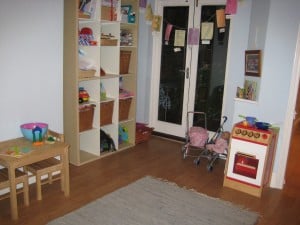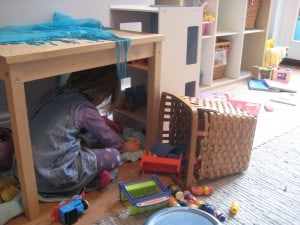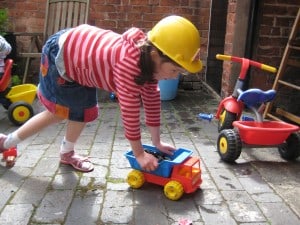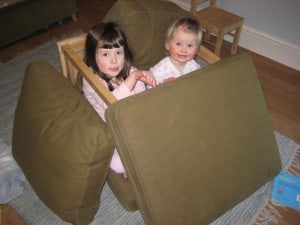So here we are on 1st January and, after helping the children with theirs yesterday, I’ve been thinking about what resolutions I’m making myself, especially about how I can nurture my family this year. Over at notimeforflashcards Allie has been rounding off an inspirational year with a review of her most popular posts from 2009, and in number one spot she’s sent out a call to ‘Let them play‘. This got me thinking that letting children play is really the most important thing we can do to nurture their learning. I believe children learn best by doing (not just watching or listening) and giving them the space to be creative and explore is vital. Filling their weeks with non-stop activities isn’t the way I want to spend 2010.
So, here are my suggestions for making 2010 the Year of Play in your home:
 1. Make an enabling environment. If you can arrange the play space in your house so that your children can access toys independently it means they are able to be in charge of their own play and use their imagination. We have open shelving in our play-room, with toys sorted into baskets with photos on to show what’s inside. This means that if my daughter is playing with her toy dog and needs some wooden blocks to build a kennel she knows exactly where they are to include in her play.
1. Make an enabling environment. If you can arrange the play space in your house so that your children can access toys independently it means they are able to be in charge of their own play and use their imagination. We have open shelving in our play-room, with toys sorted into baskets with photos on to show what’s inside. This means that if my daughter is playing with her toy dog and needs some wooden blocks to build a kennel she knows exactly where they are to include in her play.
2. Provide open-ended resources. I like to  provide different props to spark play ideas and I favour open-ended resources. So I’d rather give them wooden blocks, fir cones and sea shells, and different scarves and fabrics which they can use in anyway they want rather than a ‘toy’ which runs on batteries and only does one type of thing when you press a button.
provide different props to spark play ideas and I favour open-ended resources. So I’d rather give them wooden blocks, fir cones and sea shells, and different scarves and fabrics which they can use in anyway they want rather than a ‘toy’ which runs on batteries and only does one type of thing when you press a button.
3. Let them have freedom to play their way. So, I know that a jigsaw should be put together to make a nice picture but my daughter wants to put the pieces in a saucepan and ‘cook’ them. Is she wrong? Of course not, and if you encourage this child-led play you’re giving you child valuable space to explore what’s important and interesting to them.
4. Sit back and watch. Taking the time to really observe how your child is playing gives a window into what they’re ready to learn. By watching you can find out what they’re really interested in and use that as a springboard for other activities to develop their knowledge and understanding. Maybe they’re spending a lot of time playing with cars and you realise that it’s the circular motion of the wheels that’s fascinating them. You could then offer them some balls and a ramp to explore, or make a windmill together. Children don’t learn things in isolation but instead link together information and experiences. So if your child has been playing with a toy farm, combining this with a visit to a real farm, making a tractor from a big cardboard box and reading stories and singing songs songs all about animals is a very effective way to nurture their learning.
5. Sneak in the English, maths and science. Of course it’s important to incorporate these in your child’s world but this shouldn’t be instead of play. Therefore, your job is to ditch the flashcards and in their place include numbers and letters almost without the children realising. If they’re playing ‘shops’ you can make an ‘Open / Shut’ sign for the door and price tags for the produce. When you’re having a teddy bears’ picnic you can count how many plates you need. Adding different sized funnels and buckets to the sandpit or at bathtime lets them explore different volumes. And growing a sunflower in the garden is a great way to introduce biology.
How about you? What will your focus be for nurturing your children in 2010 – I’d love to hear your plans.
Happily shared with ABCand123’s Let’s Get Organised



